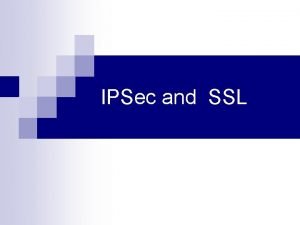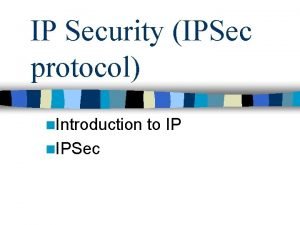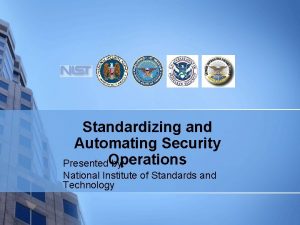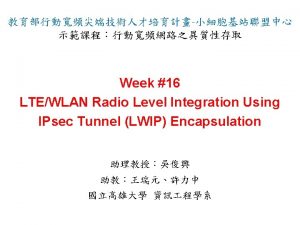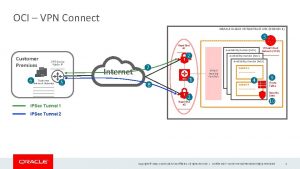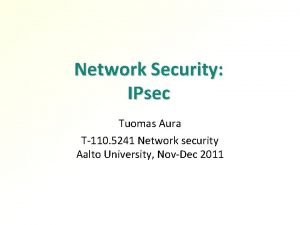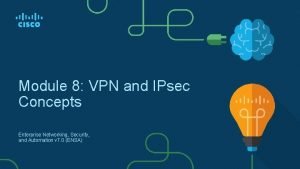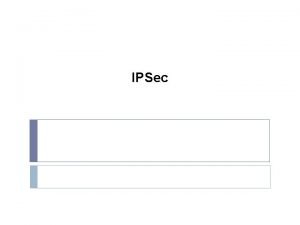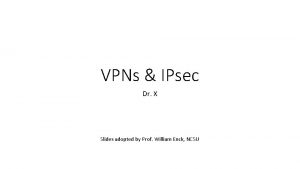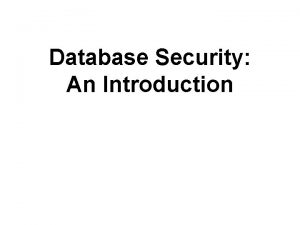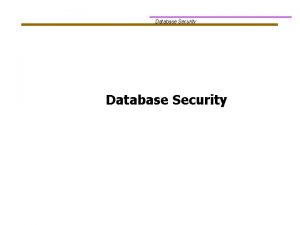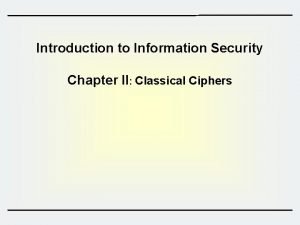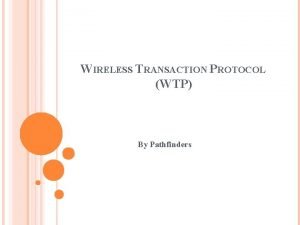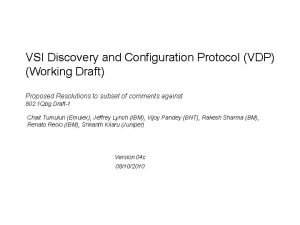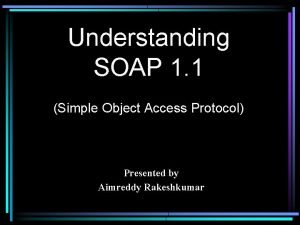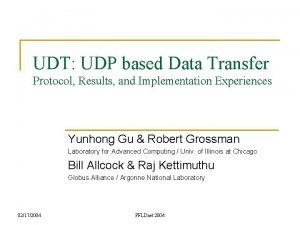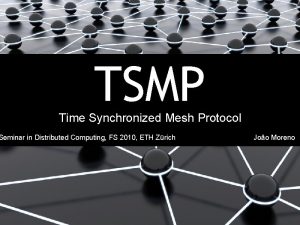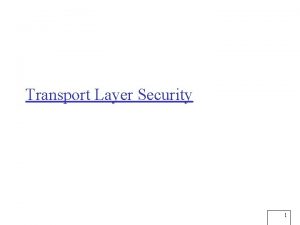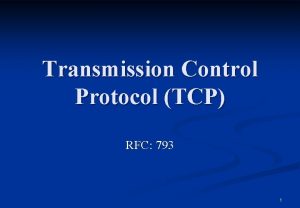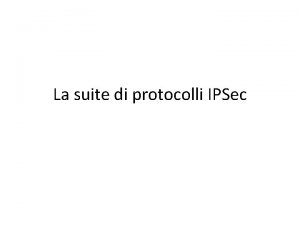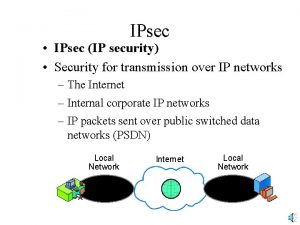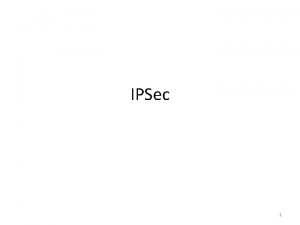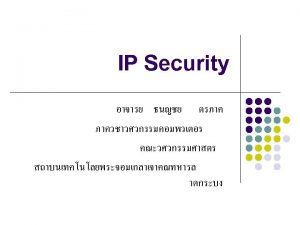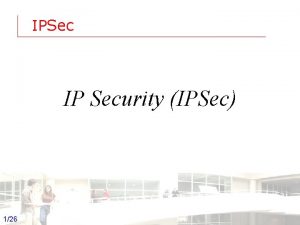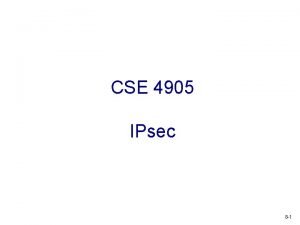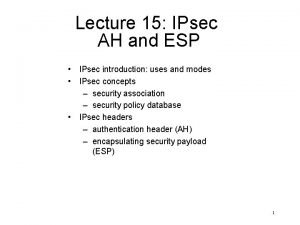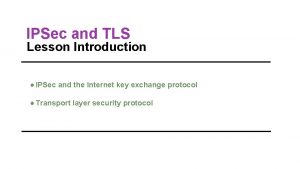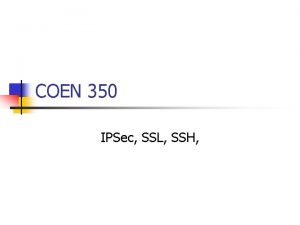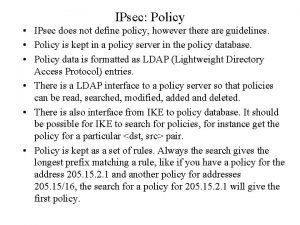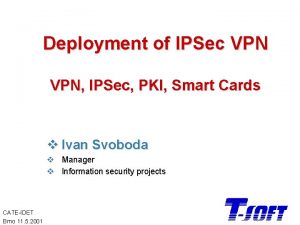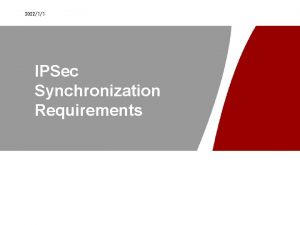IP Security IPSec protocol n Introduction n IPSec


















































- Slides: 50

IP Security (IPSec protocol) n. Introduction n. IPSec to IP

Internetwork Protocol (IP) n Aim – provide interconnection across different networks n implemented in every end user and in routers n IP is an unreliable protocol – IP datagrams may be lost – IP datagrams may arrive out of order – TCP takes care of those problems

Internetwork Protocol (IP)

IPv 4 n The IP version that we are currently using on SU campus – actually most IP networks are IPv 4 Data (Payload) follows the header

IPv 6 n Next generation IP – driving force was the inadequateness of IPv 4 address space n IPv 6 header – modular approach – base header + extension headers – base header is longer than v 4, but number of fields is smaller

IPv 6 header

Is IP Secure? n Content (Payload) is not encrypted – confidentiality is not provided – IP sniffers are available on the net n IP addresses may be spoofed – authentication based on IP addresses can be broken n So IP is not secure

Where to provide security? n Application layer? – S/MIME, PGP – email security – Kerberos – client / server – SSH – secure telnet n Transport level? – SSL / TLS – between TCP and Application n IP level – IPSec

IPSec general IP Security mechanisms n provides authentication and confidentiality at IP level n – also has key management features n Applications – VPNs (Virtual Private Networks) • Interconnected LANs over the insecure Internet • router to router – Secure remote access, e. g. to ISPs • individual to router n IPSec support is mandatory for IPv 6 products, optional for v 4 – many manufacturers support IPSec in their v 4 products

IPSec Application Scenarios

Benefits of IPSec n in a firewall/router, IPSec provides strong security to all traffic entering the network – without passing the security overhead to the internal network and workstations – user transparent: no need to assume security aware users, no per user keys n IPSec is below transport layer – transparent to applications – No need to upgrade applications when IPSec is used, even if the IPSec is implemented in user machines n can provide security for individual users – not so common – may be useful for telecommuters

IPSec Architecture IPSec and its specifications are quite complex n defined in numerous RFCs n – most important RFCs are 2401 (Overview of security architecture), 2402 (AH Authentication Header), 2406 (ESP – Encapsulating Security Payload – for encryption), 2408 (ISAKMP – Key Management), 2409 (IKE – Key Management) – many others, see IETF IPSec Working Group website • http: //www. ietf. org/html. charters/ipsec charter. html

IPSec Protocols n Authentication Header (AH) – defines the authentication protocol – no encryption n Encapsulating Security Payload (ESP) – provides encryption – optionally authentication Crypto algorithms that support those protocols are generally defined in other documentation n Key distribution and management are also in different RFCs n

IPSec Services

Security Associations (SA) n a one way relationship between sender & receiver – specifies IPSec related parameters n Identified by 3 parameters: – Destination IP Address – Security Protocol: AH or ESP – Security Parameters Index (SPI) • A local identifier n There are several other parameters associated with an SA – stored in Security Association Database

SA Parameters (some of them) n Anti replay related – Sequence Number Counter • to generate sequence numbers – Anti replay window • something like sliding window. discussed later. n AH info – authentication algorithms, key lifetimes, etc. n ESP info – encryption (and authentication) algorithms, key lifetimes, etc. Lifetime of SA n IPSec Mode: Transport or Tunnel n

SA, AH – ESP, and key management n SAs are in databases – both in sender and receiver AH and ESP use the cryptographic primitives and other info in SA n Key Management Protocols (will discuss later) are to establish SA n So n – AH / ESP are independent of key management

SA Selectors n IPSec is a flexible protocol – traffic from IP address X to IP address Y may use several SAs • or no SA if that particular traffic will not be secured n Security Policy Database (SPD) is used to assign a particular IP traffic to an SA – fields of an SPD entry are called selectors n Outbound processing – compare the selector fields of SPD with the one in the IP traffic – Determine the SA, if any – If there exists an SA, do the AH or ESP processing

Some SA Selectors n Destination and Source IP addresses – range, list and wildcards allowed n Transport Layer Protocol – TCP, UDP, ICMP, all n Source and Destination Ports – list and wildcards allowed – from TCP or UDP header n etc.

Transport and Tunnel Modes n Both AH and ESP support these two modes – differently (will see later) n Transport Mode – security is basically for the IP payload (upper level protocol data) – IP header is not protected (except some fields in AH) – Typically for end to end communication n Tunnel Mode – – secures the IP packet as a whole incl. header(s) actually puts all IP packet within another (outer) one packet is delivered according to the outer IP header Typically for router to router, or firewall to firewall communication

Authentication Header (AH) n provides support for data integrity and authentication of IP packets – malicious modifications are detected – address spoofing is prevented – replays are detected via sequence numbers n Authentication is based on use of a MAC – parties must share a secret key • in SA

Authentication Header Next Header: specifies next header or upper layer protocol Payload length: to specify header length SPI: to identify SA Sequence number: used for replay control Authentication data: MAC value (variable length)

AH – Anti-replay Service Detection of duplicate packets n Sequence numbers n – associated with SAs – 32 bit value – when an SA is created, initialized to 0 • when it reaches 232 1, SA must be terminated • not to allow overflows – sender increments the replay counter and puts into each AH (sequence number field) n Problem: IP is unreliable, so the receiver may receive IP packets out of order – Solution is window based mechanism • İmplemented at receiver side

AH – Antireplay Service window size W (default is 64) n If a received packet falls in the window N: highest seq. number for a valid paket recevied so far – if authenticated and unmarked, mark it – if marked, then replay! n If a received packet is > N – if authenticated, advance the window so that this packet is at the rightmost edge and mark it n If a received packet is <= N W – packet is discarded

AH - Integrity Check Value (ICV) Actually it is a MAC n HMAC is used n – with either SHA 1 or MD 5 – default length of authentication data field is 96 • so HMAC output is truncated n MAC is calculated over – IP payload (upper layer protocol data) – IP Headers that are “immutable” or “mutable but predictable” at destination • e. g. source address (immutable), destination address (mutable but predictable) • Time to live field is mutable. Such mutable fields are zeroed for MAC calculation – AH header (except authentication data)

AH – Transport Mode transport mode tunnel mode

AH – Tunnel Mode Inner IP packet carries the ultimate destination address Outer IP packet may carry another dest. address (e. g. address of a router at destination network) new transport mode tunnel mode

Encapsulating Security Payload (ESP) n provides – message content confidentiality • via encryption – limited traffic flow confidentiality and measures for traffic analysis • by padding (may arbitrarily increase the data) • by encrypting the source and destination addresses in tunnel mode – optionally authentication services as AH • via MAC (HMAC), sequence numbers n supports range of ciphers, modes – DES, Triple DES, RC 5, IDEA, Blowfish, etc. – CBC is the most common mode

Encapsulating Security Payload (IP Payload)

Padding in ESP n several purposes and reasons – encryption algorithm may require the plaintext to be multiple of some n – ESP format requires 32 bit words – additional padding may help to provide partial traffic flow confidentiality by concealing the actual length of data

Transport Mode ESP n transport mode is used to encrypt & optionally authenticate IP payload (e. g. TCP segment) – data protected but IP header left in clear – so source and destination addresses are not encrypted – Mostly for host to host (end to end) traffic

Tunnel Mode ESP n Encrypts and optionally authenticates the entire IP packet – add new header for processing at intermediate routers • may not be the same as the inner (original) header, so traffic analysis can somehow be prevented – good for VPNs, gateway to gateway (router to router) security • hosts in internal network do not bother with security related processing • number of keys reduced • thwarts traffic analysis based on ultimate destination

Tunnel Mode ESP

Tunnel Mode ESP

Combining Security Associations SA’s can implement either AH or ESP n to implement both, need to combine SA’s n – form a security association bundle n A possible case: End to end Authentication + Confidentiality – Solution 1: use ESP with authentication option on – Solution 2: apply ESP SA (no auth. ) first, then apply AH SA – Solution 3: Apply AH SA first, then ESP SA • encryption is after the authentication

Key Management in IPSec n Ultimate aim – generate and manage SAs for AH and ESP – asymmetric • receiver and initiator have different SAs n can be manual or automated – manual key management • sysadmin manually configures every system – automated key management • on demand creation of keys for SA’s in large systems

Key Management in IPSec n Complex system – not a single protocol (theoretically) – different protocols with different roles • intersection is IPSec • but may be used for other purposes as well n Several protocols are offered by IPSec WG of IETF – Oakley, SKEME, SKIP, Photuris – ISAKMP, IKE n IKE seems to be the IPSec key management protocol but it is actually a combination of Oakley, SKEME and uses ISAKMP structure n See IPSec WG effort at http: //www. ietf. org/html. charters/ipsec charter. html

Oakley Key exchange protocol based on Diffie Hellman n have extra features n – cookies • precaution against clogging (denial of service) attacks – makes the attack more difficult • cookies are unique values based on connection info (kind of socket identifiers) • used at every message during the protocol – predefined groups • fixed DH global parameters • regular DH and ECDH – nonces • against replay attacks – authentication (via symmetric or asymmetric crypto)

ISAKMP Internet Security Association and Key Management Protocol n defines procedures and message formats to establish, negotiate, modify and delete SAs n – SA centric, so some calls it only a SA management protocol • but we have keys in SAs – ISAKMP is NOT key exchange protocol independent of key exchange protocol, encryption algorithm and authentication method n IKE combines everything n Do. I (Domain of Interpretation) Concept n – the scope of SA (not only IPSec)

ISAKMP n Typical SA establishment protocol run in ISAKMP – Negotiate capabilities • Do. I, encryption algorithms, authentication methods, key exchange methods, etc. – Exchange keys • using the method agreed above – Authenticate the exchange • digital signatures based on certificates • public key authentication using previously exchanged public keys • symmetric crypto based authentication based on previously shared secret (e. g. manual entry)

ISAKMP Header

ISAKMP Payloads n ISAKMP has several payload types – chaining (each payload points to the next one) – they are used to carry different types of information for SA generation and management n Some payload types – SA payload • to exchange the Do. I information – Proposal and Transform payloads • to exchange the security and crypto capabilities in the Do. I – Key Exchange payload • to exchange the key exchange info – Others (e. g. nonce, identification, certificate request, signature, …)

ISAKMP Protocol Flow (Message Exchange) negotiate / key exchange / authenticate n 5 such ISAKMP message exchanges are proposed n – will go over two important ones here • identity protection exchange • aggressive exchange – each message is one ISAKMP message (header + payloads) • main header includes cookies for each message • each step specifies which payloads exist • SA payload means (SA + proposal + transform) payloads

Identity Protection Exchange * means encrypted message payload – that is why identity is protected n AUTH is the authentication information, such as digital signatures

Aggressive Exchange n minimizes the number of exchanges but does not provide identity protection

IKE (Internet Key Exchange) n now we are ready to go over IKE – the actual protocol used in IPSec – uses parts of Oakley and SKEME • and ISAKMP messages – to exchange authenticated keying material n Analogy for the protocols – ISAKMP: railways, highways, roads – Oakley, SKEME: prototypes for cars, trains, buses (and other vehicles) – IKE: a system that has several vehicles running on railways, highways, roads

IKE n Perfect forward secrecy (from SKEME) – disclosure of long term secret keying material does not compromise the secrecy of exchanged keys from earlier runs n PFS in IKE (basic idea) – Use a different DH key pair on each exchange • of course they have to be authenticated, probably with a digital signature mechanism • however, disclosure of the private key (long term key) for signature does not disclose earlier session keys

IKE n Authentication Methods of IKE – certificate based public key signature • certificates are exchanged – public key encryption • Some key material exchanged using previously known public keys • no certificates, so no non repudiation – pre shared key • symmetric method • simplest, no public key crypto n Material to be authenticated is derived from the messages exchanged

Phases of IKE n Phase 1: establish IKE SA – Main mode (DH with identity protection) • ISAKMP identity protection exchange – Aggressive mode (DH without identity protection) • ISAKMP aggressive mode n Phase 2: establishes SA for target protocol (AH or ESP) – Quick mode (only 3 exchanges) – IKE SA is used to protect this exchange – Several SAs can be established in quick mode

Midterm Exam n April 29, 2010, Thursday – Class hour (15: 40 – 17: 30) – FENS auditorium – Topics covered: until the end of IPSec – Closed everything, calculators are OK
 Ipsec protocol suite
Ipsec protocol suite Ssl protocol architecture
Ssl protocol architecture Ip security ipsec
Ip security ipsec Private secruity
Private secruity Security content automation protocol (scap)
Security content automation protocol (scap) Security architecture for the internet protocol
Security architecture for the internet protocol Ipsec vs ssl vpn
Ipsec vs ssl vpn Vpp ipsec
Vpp ipsec Lwip ipsec
Lwip ipsec Oracle vpn connect
Oracle vpn connect Ipsec
Ipsec Ipsec
Ipsec Vpn and ipsec concepts
Vpn and ipsec concepts Ipsec key management
Ipsec key management Ipsec
Ipsec Ipsec
Ipsec Ovn ipsec
Ovn ipsec Ncsu vpn
Ncsu vpn Untangle ipsec vpn setup
Untangle ipsec vpn setup Osi security architecture in hindi
Osi security architecture in hindi Guide to network security
Guide to network security Wireless security in cryptography and network security
Wireless security in cryptography and network security Visa international security model in information security
Visa international security model in information security Electronic mail security in network security
Electronic mail security in network security Cnss model
Cnss model Electronic commerce security
Electronic commerce security Software security building security in
Software security building security in Security guide to network security fundamentals
Security guide to network security fundamentals Security guide to network security fundamentals
Security guide to network security fundamentals Introduction to database security
Introduction to database security Security mechanisms in cryptography
Security mechanisms in cryptography 395495
395495 Introduction to database security
Introduction to database security Introduction to cryptography and network security
Introduction to cryptography and network security Introduction to information security chapter 2
Introduction to information security chapter 2 Introduction to email security
Introduction to email security Introduction to cryptography and network security
Introduction to cryptography and network security Essay structure introduction
Essay structure introduction Ica protocol
Ica protocol Wtp allows for
Wtp allows for Warfarin
Warfarin Rogers score dvt
Rogers score dvt Vdp protocol
Vdp protocol Simple object access protocol
Simple object access protocol What is skinny client control protocol
What is skinny client control protocol First hop redundancy protocol cisco
First hop redundancy protocol cisco Udt protocol
Udt protocol Tsmp protocol
Tsmp protocol Ssh protocol stack
Ssh protocol stack Rfc tcp protocol
Rfc tcp protocol Dslforum cpe management
Dslforum cpe management

